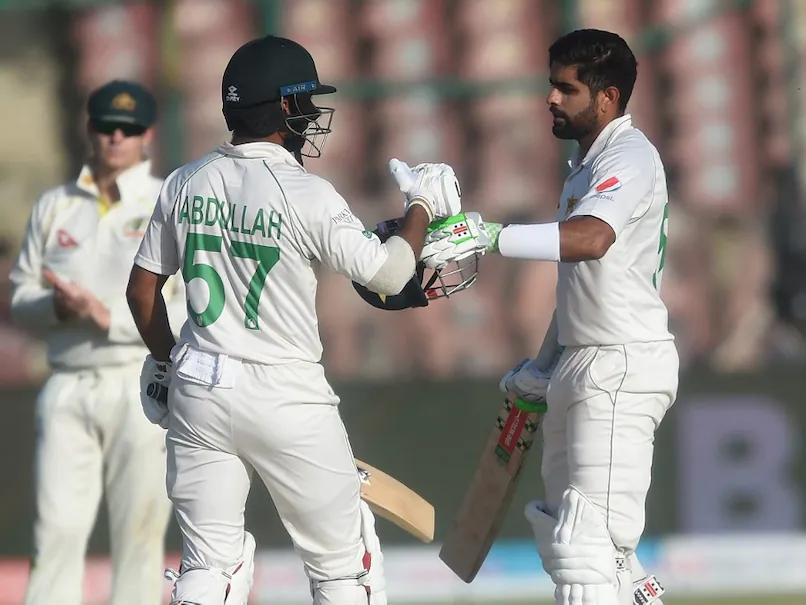So, after a couple of exceptionally boring tests, Australia have won the final test and thereby the series. It was a commendable performance from Australia. They were not even expected to compete but have now ended the series by winning it. Coming on the heels of a resounding Ashes win, this must certainly taste sweet for Cummins. At the moment, it seems he can do no wrong. Whatever he does turns to gold. All the more the fact that he was instrumental in the series win with the ball. The 5 wickets in the first innings of the third test, virtually ensured that Pakistan cannot win. However, I do feel that Pakistan lost because of their own stupidity.
Pakistan were let down by the lack of crowd
I am certainly not exaggerating. If only Pakistan had been a bit bolder, they would have won the series handsomely. Cricket returned to Pakistan after close to a decade. It was supposed to be a celebration. Crowds were expected to throng the stadiums but what was witnessed was mostly empty stands. On the last day of the 3rd test, with Pakistan chasing an improbable 351 to win and having started the day at 75 without loss and with a chance to create history, if you had expected the fans to turn up in huge numbers to support their team, you would not have been wrong. However, only a handful turned up.
It was because of that Pakistan never really got the support of the home crowd. Probably, the PCB did not promote the game enough or did not inspire the crowd to come over to the stadium. This was their first mistake.
Pakistan was scared of Australia
Coming to the cricket itself, Pakistan were clearly feeling the pressure. Even before a ball was bowled, they seemed to have resigned to the fact that they are no match for Australia. They never believed in their ability to defeat Australia. Perhaps, they were influenced by Australia’s dominating performance in The Ashes. What Pakistan failed to understand is that that was achieved in a completely different environment where the pitches favoured the Australian pacemen.
Lack of turn on the pitches hurt Pakistan badly
In an effort to not lose the series, Pakistan prepared pitches that were slow and low and without any help for the bowlers. Either the spinners or the fast bowlers. This played right into the hands of Australia. Whenever a team outside of the sub-continent tours Asia, they expect to play on spinning tracks. They come prepared for that. Marnus Labuschagne’s famous video, of him, practising with tapes and thereby trying to replicate the turning conditions, showed clearly that the Australians expected the pitches to turn. What they came across must have come as a pleasant surprise for them.
The pitches in all the 3 games never turned. It was purely because of Pakistan’s fear of the might of Australia. There is no other way to explain this lack of spin. A few years ago, against South Africa, in UAE, Pakistan prepared pitches that were a nightmare for any bowler. It was out of sheer fear of South Africa. So much so that a bowler like Dale Steyn was reduced to a mere club bowler. Much the same happened in this series as well. This brought the Aussie batsmen right into the game. They were able to trust the pitch and play the ball knowing fully well that it is not going to turn. The Aussie batsmen made merry.
Lack of decisiveness on the part of the Pakistan batsmen
Another factor for Pakistan’s loss was their scared batsmen. Never once did they threaten to bat aggressively. The batsmen gave ample amount of time to the Aussie bowlers to settle into a nice rhythm. Lyon and Swepson were not taken for runs either. Australia probably went into the series wanting the draw. Pakistan obliged them by their inept attitude. It was really a mystery that Pakistan did not trust their spinners to deliver them series win. Afridi and Naseem Shah were given much more importance when their spinners could have won the series.
Australia have reasons to smile
As for Australia, at the moment, they are riding on a high. After the clinical annihilation of England, they have one more series win and this time in the tough Asian environs. Cummins has secured his 2nd successive series win. They have justified their ranking as the number one but firmer challenges await them. The 4 test series against India later this year will show where they are placed. It will be a much more tougher challenge for Australia. If the first choice Indian players remain fit, Australia will be hard pressed to win a test.
Having said that, the form of Usman Khawaja, on whom the entire Australia win in Pakistan was setup must encourage Australia. The form of Cummins and Starc, with their ability to reverse swing will also give them much to cheer about. Lyon picking up a 5-fer on the last day will reinforce the fact that he is indeed Australia’s number one spinner. Swepson will have to wait for a very long time to replace him that is provided he improves manifold. However, the failure of Marnus and Smith will rankle them. Smith is a modern day great and he will motivate himself against tougher opponents. For some reason, India brings the best out of him. He hasn’t gone a single series against India without a century. The true test of Marnus’s ability will come into sharp focus in India.
Conclusion to Pakistan lost because of their own stupidity
Cummins would not have expected his luck. He would have wanted his team to fight as much as possible but he would not have expected a timid Pakistan. He must be given credit for accepting the opportunity and to have fashioned a famous series win. India will certainly challenge his captaincy credentials and followed by next year’s Ashes, it will be litmus test for Cummins.



